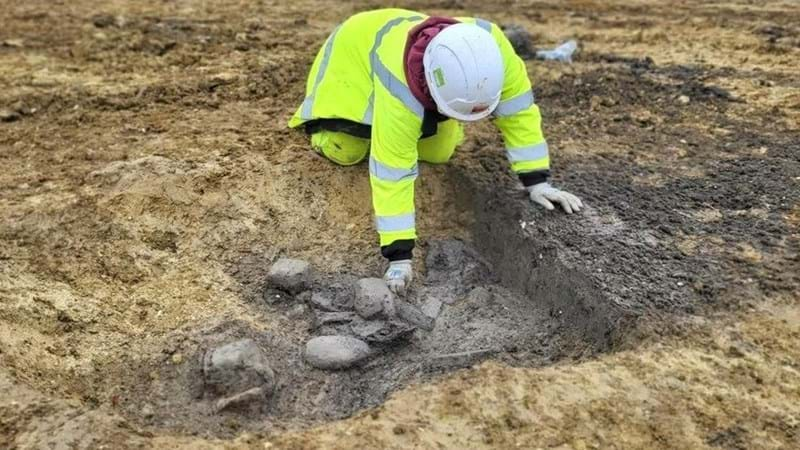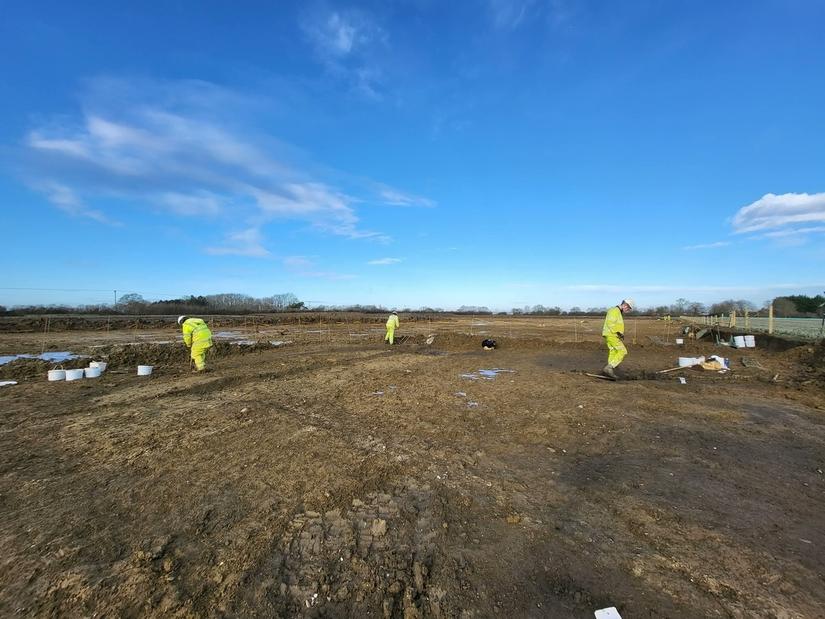Life's a ditch on the A428
Published
20 Feb 2024
We’ll let you into a secret – archaeologists love ditches. Here on the A428, it's not even that much of a secret. Our archaeologists can’t get enough of ditches, and some of our most interesting finds have been lying in wait at the bottom of one!

Share this article
What’s so great about ditches?
The best thing about ditches is... they don’t stay empty for long! They get filled up with all sorts of rubbish, which is another of our favourite things. What people throw away says a lot about their lifestyles, the work they were doing on the site, and even where they were getting their kitchen pots from!
What would an archaeologist be able to find out about you from what's inside your rubbish bin?
What our archaeologists, MOLA, find in ditches can help them to date a site. If they found a site with ditches full of Roman artefacts, such as broken Samian ware pottery, but only a few objects at the bottom of the ditch dating to the Iron Age, and nothing from the early medieval period, what does that say?
It suggests there was a small amount of activity on the site during the Iron Age, when the ditch was first dug. The site then became a lot busier, and maybe wealthier, during the Roman period, with expensive goods being imported from around the empire. If there are no artefacts from the earlier medieval period, this means the site was probably abandoned at the end of the Roman period. This was the case for many of the settlements we have excavated so far across our A428 scheme.
It's not just about rubbish!
Ditches were dug for lots of different reasons! They could be:
-
defensive
-
to collect or channel away water
-
for farming or planting crops
-
marking land boundaries
-
around monuments such as barrows

Ditches are also often recut; this means the soil or waste that was building up inside them in removed. Sometimes they are backfilled. This means they are deliberately and quickly filled with soil to get rid of the ditch. This sort of activity helps us understand how the site was used in the past. If a ditch is suddenly filled in, that might mean a change of use for the site. When we excavate a ditch, we can see where they have been recut and backfilled as different coloured or textured layers in the soil.
If we’re lucky, we might find the ditch is waterlogged. While this means our excavations might get quite muddy, there’s also the chance we could find organic material such as wood or plant pollen preserved for thousands of years!
What have we found in ditches on the A428?
More like... what haven’t we found!
Animal remains
Animal skeletons, including a fox, horses, pigs, and a full set of deer antlers.
Frog bones
Frog bones: these tiny bones are just 1cm in length. They were spotted by our keen-eyed processing team in a soil sample. If frogs were living in the ditch, it was probably wet!
A possible feast
The remains of large cooking pots, animal bones, and big burnt stones. This was no ordinary ditch – it was a ring ditch around a barrow (a burial monument). Could this be rubbish from a funerary feast?
Grapes
Grape pollen: another amazing find from our environmental archaeologists! Does this mean the inhabitants of this Roman settlement were having a go at making their own wine?
Rubbish
Lots of everyday household rubbish, like broken bits of pot, people’s broken jewellery, and this mystery piece of metal – what do you think it is, and why do you think it was thrown away?
MOLA's A428 excavations are continuing, so make sure you keep an eye on social media for updates from the field, including our ditch-based discoveries!
Sign up for updates
Keep updated on the A428 Black Cat to Caxton Gibbet improvements
Sign up for updates